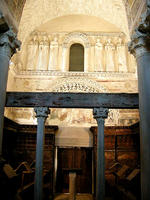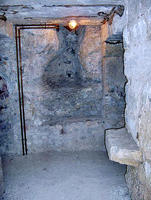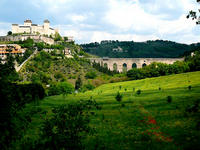You are in: Europe -> Italy -> Longobards in Italy.... , and traditional search or Image Gallery will yield results of this site only
Longobards in Italy. Places of the power (568-774 A.D.)
| Site number: | 1318 |
|
| Type of site: | Cultural | |
| Date: | 568 - 774 | |
| Date of Inscription: | 2011 | |
| Location: | Europe, Italy (nation wide) | |
Up to 75 images are shown here. Click on each for more details or on Image Gallery for more images.
| Description: | The Longobards in Italy, Places of Power, 568 - 774 A.D. (Italy) comprises seven groups of important buildings (including fortresses, churches, and monasteries) throughout the Italian Peninsula. They testify to the high achievement of the Lombards, who migrated from northern Europe and developed their own specific culture in Italy where they ruled over vast territories in the 6th to 8th centuries. The Lombards synthesis of architectural styles marked the transition from Antiquity to the European Middle Ages, drawing on the heritage of Ancient Rome, Christian spirituality, Byzantine influence and Germanic northern Europe. The serial property testifies to the Lombards' major role in the spiritual and cultural development of Medieval European Christianity, notably by bolstering the monastic movement. --WHMNet's description is from WHC Site, where additional information is available. | |
| Longobards in Italy. Places of the power (568-774 A.D.) is the official name given by UNESCO to seven groups of historic buildings that reflect the achievements of the Germanic tribe of the Lombards (also referred to as Longobards) who settled in Italy from the sixth to the eighth century. The groups comprise monasteries, church buildings and fortresses and became UNESCO World Heritage Sites in June 2011 as they testify "to the Lombards' major role in the spiritual and cultural development of Medieval European Christianity.” List of sites include: 1. Cividale del Friuli (Province of Udine): The Gastaldaga area and the Episcopal complex; 2. Brescia: The monumental area with the monastic complex of San Salvatore-Santa Giulia ; 3. Castelseprio (Province of Varese): The castrum with the Torba Tower and the church outside the walls, Santa Maria foris portas; 4. Spoleto (Province of Perugia): The basilica of San Salvatore; 5. Campello sul Clitunno (Province of Perugia): The Clitunno Tempietto; 6. Benevento: The Santa Sofia complex; and 7. Monte Sant'Angelo (Province of Foggia): The Sanctuary of San Michele. --Wikipedia. Text is available under the Creative Commons Attribution-ShareAlike License. | ||
| Source: | http://whc.unesco.org/en/list/1318 | |
| Reference: | 1. UNESCO World Heritage Center (http://whc.unesco.org/en/list/1318). 2. Wikipedia. | |






















































